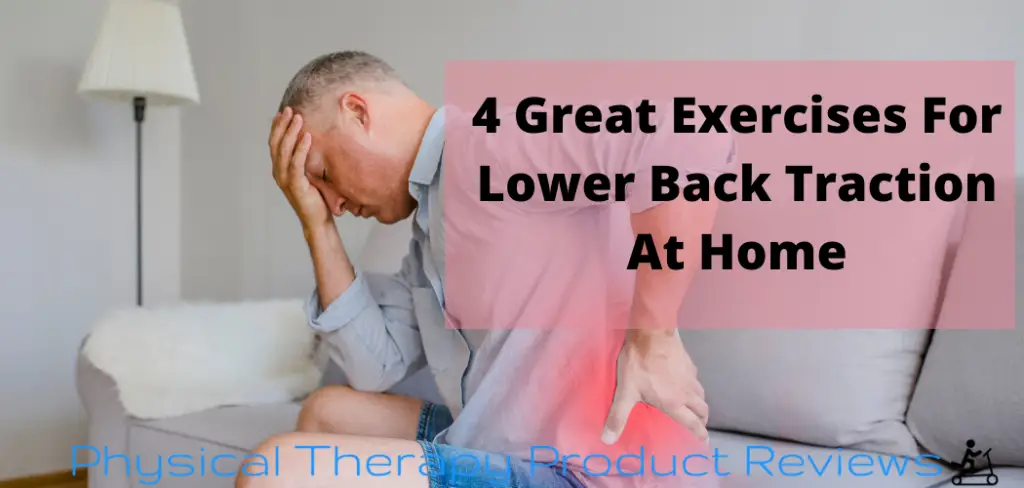If you’ve been experiencing back pain, chances are, there is nothing you wouldn’t do to alleviate it! You’ve probably tried it all: hot water bottles, massage, back brace, medication…the list goes on.
There are expensive machines that you can buy to give you back traction but have you tried the inexpensive route yet?
One treatment that is easy to do at home and may offer you some relief is lumbar traction!
What is Lower Back Traction?
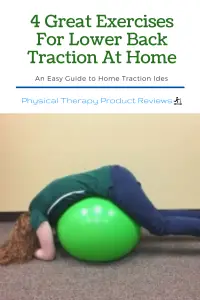 The term lumbar traction refers to the act of assuming a position to stretch the low back region. The intention is that when a stretch is applied to this area, it can decompress the spine and relieve local pain while providing more space for structures that may be compacted.
The term lumbar traction refers to the act of assuming a position to stretch the low back region. The intention is that when a stretch is applied to this area, it can decompress the spine and relieve local pain while providing more space for structures that may be compacted.
The spine is solid and stable; thus, isolating a motion to this area can be challenging. Yet, some specific exercises and positions can allow you to focus a force on the low back and stretch the musculature and joints that may be causing compression symptoms.
What are the Benefits to Lumbar Traction?
When performed correctly, lower back traction can relieve patients suffering from radiating symptoms like pain and numbness. Traction can ease pain levels and thus open the door to improving quality of life and daily function.
Some of the main benefits include:
- Decreased nerve compression
- Decreased pressure on the discs and vertebrae
- Light stretching on the muscles, tendon, and ligaments
- Can help with reducing swelling
Home Traction vs. Clinical Traction
There are many variables to the type of traction that can be applied to the low back. In a clinic setting, a provider will typically use mechanical traction. This modality uses weights and pulleys to apply a tension stretch to the low back.
At home, a patient can replicate this treatment, to a degree, by using the exercises described below. You may not achieve the same level of tension, but these methods are more convenient, easily accessible, and can still provide benefits.
Who Should do Lumbar Traction?
The person who would most benefit from including traction in their home exercise plan is likely someone with nerve root compression and peripheralizing symptoms. This is especially so when that peripheralizing pain down the leg worsens with back extension movements.
Research shows that unless a patient is experiencing nerve root compression, they probably won’t notice any difference after traction. So, better treatment includes walking for exercise and performing core stabilization for those with acute or chronic low back pain without nerve symptoms.
Is an Inversion Table the Same as Traction?
Yes, an inversion table does the same thing as spinal traction, decompress the spine.
Inversion therapy is using a table to reduce the pressure on the spine by going upside down and using gravity to decompress and stretch the spine out.
An inversion table is an easy way to achieve this at home without having to use expensive and fancy equipment in the clinic.
However, not everyone should use an inversion table. Anyone with glaucoma, certain blood pressure disorders, severe osteoporosis, and those that can’t tolerate being upside down should avoid using an inversion table.
To see our review of our favorite inversion tables for home use, see this article here.
4 Exercises for Lower Back Traction at Home
Plenty of fancy devices for sale will happily empty your wallet to help you complete low back traction at home. Thankfully, there are also a few great ways to use traction without the need for complicated equipment!
Swiss Ball Traction
Take a large Swiss ball and position yourself on top of it, facing down. Your stomach should be resting on top of the ball.
Relax your back and hips and roll forwards slightly, so your knees rise from the ground. Gravity will provide resistance from your hips downward to stretch your lower back.
Hold for 30-45 seconds and repeat several times.
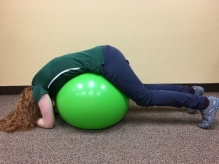
Table Back Traction
For the Lower Back
Stand at the edge of a very sturdy table. Bend forward to lay your torso down atop the table. Release pressure from your feet slowly. You will feel the pull of gravity from your lower back and hips. Find the level of decompression that feels best to you.
Hold for 30-45 seconds and repeat several times.
For the Upper Back
It is best to use a bed for this method. Lay down on your back with your head pointing towards the foot of the bed. Edge your body closer to the foot of the bed until your head, and the top of your shoulders begin to come off the edge. Do not go so far as to make yourself unbalanced and close to falling.
You may find it more comfortable to place a small pillow under your legs for this position.
Hold for 30-45 seconds and repeat several times.
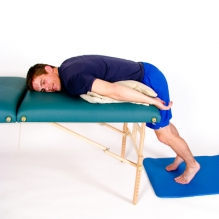
Back Traction at Home
Manual Traction with help
Grab a buddy for this exercise! Lay on your back with your feet near the end of the bed. Your buddy will grasp your ankles securely.
Instruct them to lean back slowly, gently pulling on your legs. You will feel a stretch near your hips and low back. If you feel like you’re sliding off the bed, it may be helpful to brace with your arms at your sides.
Hold for 30-45 seconds and repeat several times.

Hang from the Arms Lumbar Traction
Overhead
You will need a pullup bar for this exercise. Alternatively, a visit to the monkey bars at your local playground will suffice. Reach overhead and grasp the bar. Slowly release the weight from your feet until you are hanging by your arms.
Hold about 20 seconds and repeat several times.
By the side
Position yourself between two sturdy objects that are about at the level of your wrists (i.e., the backs of two chairs / a couch back and a table).
Place one hand on each surface. Slowly release support from your feet as you transfer your weight into your hands. Keep a slight bend in your elbows, and try not to hunch your shoulders.
Gravity will provide a downward pull to release tension in your low back.
Hold about 20 seconds and repeat several times.
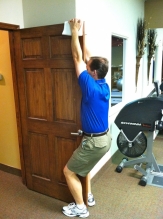
Tips for Success with Back Traction
If you notice improvements in your symptoms after using home traction, stay consistent!
Does it hurt? Probably time to stop the exercise. Some discomfort is ok and even expected. But pain during the activity, or extended pain after, is a sign that it’s not the proper exercise for you. Consult with your healthcare provider before continuing.
Don’t expect traction to work a miracle for you! The evidence is limited, and the most benefits you’ll see out of traction will be when it is included in a comprehensive rehabilitation program. That means you’re also taking care of your body with exercises, stretches, proper nutrition, and sleep. Be sure to include core stabilization, massage, and posture awareness in your routine and lifestyle.
Conclusion
There are a lot of ways to care for low back pain. Manual traction can be accomplished through many different methods, making it easy and accessible to everyone. For the patient that experiences leg numbness and peripheralizing pain from their low back, traction can be a helpful tool when combined with a comprehensive rehabilitation program!
Works Cited
Delitto A, et al. Low back pain: clinical practice guidelines linked to the international classification of functioning, disability, and health from the orthopaedic section of the american physical therapy association. Journal of Orthopaedic and Sports Physical Therapy. 2012; 42(4): A1-A57. https://www.jospt.org/doi/pdf/10.2519/jospt.2012.42.4.A1
Madson TJ, Hollman JH. Lumbar traction for managing low back pain: a survey of physical therapists in the United States. Journal of Orthopaedic and Sports Physical Therapy. 2015; 45(8): 586-595. https://www.jospt.org/doi/10.2519/jospt.2015.6036
Pergolizzi JV, LeQuang JA, Rehabilitation for low back pain: a narrative review for managing pain and improving function in acute and chronic conditions. Pain and Therapy.2020; 9: 83-96. https://link.springer.com/article/10.1007/s40122-020-00149-5
Vanti C, et al. Walking vs. other exercise for chronic low back pain – systematic review & meta-analysis. Academy of Physical Medicine. 2017; 5: 1-11. https://www.academyofphysicalmedicine.co.uk/wp-content/uploads/2018/08/16-WalkingVSotherExerciseforChronicLBP.pdf
Other Great Rehab Related Exercises
GLP Weight Loss and Back Health: Effective Strategies and Insights
How to Stay Active After Cervical Fractures: Expert Tips and Advice
Dealing with Painful Stairs After Ankle Replacement Surgery
Walking After a Total Ankle Replacement: Tips for a Successful Recovery
Exercises While Non-Weight Bearing After Ankle Replacement: Elevation, AROM, Leg Raises, and More
Ankle Pain with Stairs: Causes and Home Treatment Options
Disclaimer: The information provided in this post is for educational purposes only. This is not a substitute for a medical appointment. Please refer to your physician before starting any exercise program.
